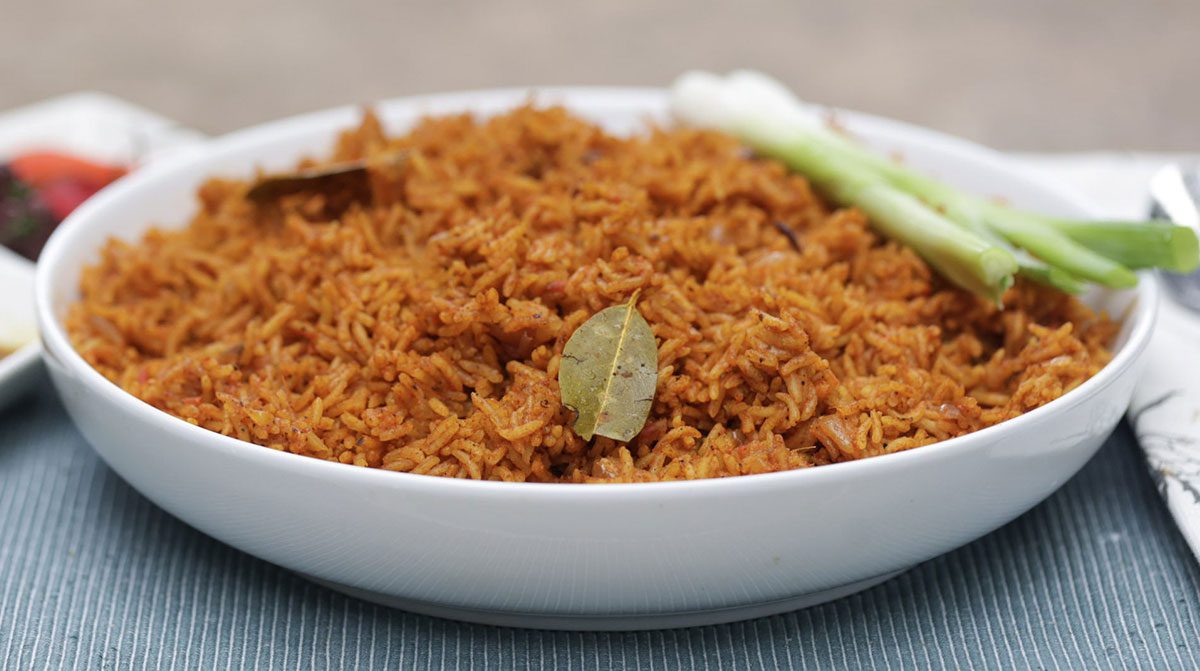Copyrights © 2025 My Afro Recipes. All rights reserved.
- Home
- Blog
- Map
- Destinations
Northern Africa
Central Africa
Eastern Africa
Western Africa
Southern Africa
Afro-Cuisine
- Meals
- Ingredients
- Shop
Jollof rice is often called the crown jewel of West African cuisine. It has also sparked one of the most famous food rivalries in the region—Nigeria vs. Ghana. Both countries claim to make the best version of this beloved dish, and the debates are just as spicy as the rice itself. Let’s break down the key differences in flavor, preparation, and cultural meaning.
Nigerian Jollof rice is rich, spicy, and smoky. Fresh tomatoes, peppers, and a mix of spices create its signature kick. Cooks often fry the sauce in oil before adding the rice, locking in flavor. The result is a vibrant red dish with an unmistakable aroma and bold taste.
Ghanaian Jollof rice, on the other hand, leans toward a milder, sweeter flavor. Onions and sometimes a hint of sugar balance the tomato base. Ghanaians often use basmati rice, giving the dish a light and fluffy texture. The spices are more subtle, creating a gentler but equally delicious profile.
This difference fuels the ongoing rivalry. Nigerians boast about the depth and heat of their version. Ghanaians argue for balance and refinement. Whether on social media or at family gatherings, the debate always sparks laughter, pride, and plenty of taste tests.
In Nigeria, Jollof takes center stage at weddings, birthdays, and everyday gatherings. It often comes with fried plantains, grilled chicken, or beef. More than a meal, it’s a symbol of unity and pride, representing the country’s vibrant food culture.
In Ghana, Jollof rice is also central to celebrations, especially national holidays like Independence Day. Families prepare it in large pots, serving it with stews or grilled fish. The dish reinforces Ghana’s communal dining tradition, where food brings people together to celebrate heritage and connection.
The Nigerian vs. Ghanaian Jollof rivalry isn’t only about flavor. It’s about history, tradition, and belonging. Nigerians celebrate spice and intensity. Ghanaians celebrate balance and community. At the end of the day, both dishes highlight the richness of West African cuisine. Whether you crave the fiery punch of Nigerian Jollof or the smooth, sweet notes of Ghanaian Jollof, one truth remains—Jollof is best enjoyed when shared.
A smoky, Nigerian style one-pot jollof rice dish simmered in a tomato-pepper sauce.

A smoky, one-pot rice dish simmered in a tomato-pepper sauce with onions, garlic, and West African spices. Bold, vibrant, and always a crowd-pleaser. This version leans Nigerian-style, with rich tomato flavor, fragrant spices, and fluffy parboiled rice.
In a blender, combine the tomatoes, red bell pepper, scotch bonnet, half the onion, garlic, and ginger. Blend until smooth. This forms the heart of your Jollof flavor.
Heat oil in a large pot over medium heat. Add the remaining chopped onions and sauté until translucent. Stir in the tomato paste and fry for 2–3 minutes to deepen the flavor. Pour in the blended sauce and let it simmer uncovered for 15–20 minutes, stirring occasionally, until it reduces and thickens. The oil should begin to separate from the sauce.
Add thyme, curry powder, bay leaf, paprika (if using), Maggi cube, and salt to the reduced sauce. Stir well. Pour in the rinsed rice and mix until the grains are coated in the sauce.
Pour in the broth and stir. Reduce heat to low, cover tightly with a lid (or foil under the lid for a better seal), and simmer for 25–30 minutes. Do not stir while cooking — this helps avoid soggy rice. Check occasionally to ensure it’s not burning; add a splash of water if needed.
Once the liquid is absorbed and the rice is tender, fluff it gently with a fork. For extra flavor, cover and let the rice steam in its own heat for 5–10 minutes. Serve hot with grilled chicken, fried plantains, or salad.
Nigerian Jollof rice is usually spicier. It uses more fresh peppers and bold seasonings, giving it a smoky, fiery kick. Ghanaian Jollof is milder and often has a slightly sweeter taste.
Most Nigerian cooks use long-grain parboiled rice, which holds up well during cooking and absorbs the rich tomato sauce. Ghanaians often prefer basmati rice, which gives the dish a lighter, fluffy texture.
Jollof rice is more than just food—it’s a symbol of celebration, community, and cultural pride. It’s a staple at weddings, holidays, and gatherings across Nigeria, Ghana, and beyond, making it a dish that unites families and friends.